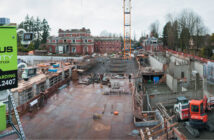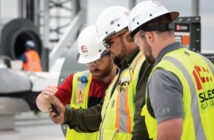
Like many industries, construction has changed quite a bit in the past 10 to 15 years. I remember the industry 40 years ago when I started, and it looks nothing like the construction of today. When I talk to contractors who have been in the construction industry for as long as I have, we end up reminiscing about how the industry was when we first began.
We all agree that technology will continue to significantly affect the construction industry. Advancements have improved areas such as computers and software, building designs, materials and methods, management, estimating, communications, education, project efficiency, tools and equipment, security, safety, and more.
And while the construction industry has sometimes lagged behind other industries in the development of technology, there have been substantial advances in recent years, including battery technology, lightweight materials, design for comfort, saw blades and drill bits that can drill through concrete with ease, and lasers that can lay out a construction site with one person.
With all these new technologies, one of the most significant advancements has been the onset of smart tools. After all, we have smart phones, smart homes, smart roads, smart cards, smart grids, and smart watches. It was only a matter of time before construction got its own set of smart toys–er, I mean, tools.
Listed below are some examples of smart technology in construction.
INFRARED CAMERA SOFTWARE
A picture is worth a thousand words. Infrared thermography diagnostic technology lets you instantly visualize and verify thermal performance. This technology can show thermal problems with the ability to see through walls and ceilings, checking for HVAC, plumbing, or roof leaks and hot spots in electrical systems. This can eliminate a host of problems and make construction more efficient. Some infrared cameras work in conjunction with your smartphone or tablet and can be helpful in quickly confirming work is acceptable before other trades commence. Software can document temperature measurement data for creating reports and can often be tailored to your specific applications. With sensor technology costs dropping and smartphones becoming more powerful, this technology will continue to be a valuable tool in many industries.
TOOL BARCODES
Unfortunately, construction tools and equipment are sometimes stolen, partially due to the high demand for tools and the ease of selling them. Barcodes can be an easy way to identify and keep track of tools and when they are checked out and returned. Embedded barcodes called tool tags are applied using strong adhesive that fuses the barcode to the tool with a chemical-resistant coating. Tool records can be created that show a barcode workflow, identifying if the tool is loaned out, available, or out of service, as well as its location.
ACCELERATING THE CONSTRUCTION PROCESS WITH 3D PRINTERS
Not long ago, the idea of using a 3D printer to construct buildings was a pipe dream. However, this innovative technology is rapidly proving useful in construction. Many experts agree that the limits are endless when it comes to 3D printing of buildings and building components. The technology has the potential to reduce the time needed for building construction and allow more complex designs.
SMART WEARABLES FOR SAFETY
Smart wearables, such as safety vests, are getting a lot of attention as technology in the construction industry improves. More money is being invested in developing wearable technologies as construction companies see the benefits, including improved efficiencies, reduced costs, and improved safety. Smart wearables collect and deliver data about the worker’s environment, activities, and biometric conditions.
DRONES
Drones have come a long way in their design and features, including advancements in software that have made them readily available in the construction industry.
There are many examples of drones being used in construction, including quick surveys of job sites, building mapping, land surveying, showing job progress to clients, monitoring job sites, inspecting structures, evaluating dangerous situations to eliminate accidents, and keeping projects on schedule.
This is an area that is developing quickly as drones become more common. It will be interesting to see how drone technology is integrated into smaller job sites!
SMARTPHONES FOR CONTRACTORS
Communication through phones on the job can be critical for contractors, and the devices must be able to withstand the harsh elements of a construction environment. It can be essential to have the capability to snap pictures, record videos, make annotations, upload data, make a phone call, and receive texts right from the job site. Some contractors choose to go with military standard phones as these can protect against extreme temperatures, shock vibration, solar radiation, dust, and water immersion. Also, most have a touchscreen that you can operate with your gloves on and even when wet. Mobile devices with easy-to-use apps may be the most extensively implemented of all the newest construction technology. The ability to instantly access project information, documentation, and changes, as well as being able to communicate with the owners, architects, engineers, and office from the job site, can help avoid a host of problems.
As the industry shifts into this technological age, I can’t help but remember where it all began for me. And I think about how most of us have adjusted to technology quite well, as it has made our lives much easier. Even with so much change, our roots in the industry still carry a special place in our hearts. That may be why our transit, stair buttons, or that Lincoln buzz box mean a bit more to us now than they did back then.




